
|
You entered: composite image
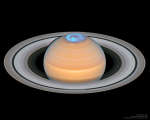 Aurora around Saturns North Pole
Aurora around Saturns North Pole
2.09.2018
Are Saturn's auroras like Earth's? To help answer this question, the Hubble Space Telescope and the Cassini spacecraft monitored Saturn's North Pole simultaneously during Cassini's final orbits around the gas giant in September 2017. During this time, Saturn's tilt caused its North Pole to be clearly visible from Earth.
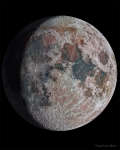 APOD: 2023 January 16 Б Moon Enhanced
APOD: 2023 January 16 Б Moon Enhanced
15.01.2023
Our Moon doesn't really look like this. Earth's Moon, Luna, doesn't naturally show this rich texture, and its colors are more subtle. But this digital creation is based on reality. The featured image is a composite of multiple images and enhanced to bring up real surface features.
 APOD: 2024 December 8 Б Aurora around Saturns North Pole
APOD: 2024 December 8 Б Aurora around Saturns North Pole
7.12.2024
Are Saturn's auroras like Earth's? To help answer this question, the Hubble Space Telescope and the Cassini spacecraft monitored Saturn's North Pole simultaneously during Cassini's final orbits around the gas giant in September 2017. During this time, Saturn's tilt caused its North Pole to be clearly visible from Earth.
 APOD: 2024 July 24 Б Exaggerated Moon
APOD: 2024 July 24 Б Exaggerated Moon
23.07.2024
Our Moon doesn't really have craters this big. Earth's Moon, Luna, also doesn't naturally show this spikey texture, and its colors are more subtle. But this digital creation is based on reality.
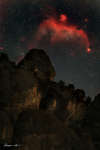 APOD: 2024 February 21 Б Seagull Nebula over Pinnacles Peak
APOD: 2024 February 21 Б Seagull Nebula over Pinnacles Peak
20.02.2024
The bird is bigger than the peak. Nicknamed for its avian shape, the Seagull Nebula is an emission nebula on the night sky that is vast, spanning an angle over five times the diameter of the full moon and over 200 light years.
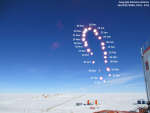 Antarctic Analemma
Antarctic Analemma
22.09.2015
Does the Sun return to the same spot on the sky every day? No. A better and more visual answer to that question is an analemma, a composite image taken from the same spot at the same time over the course of a year.
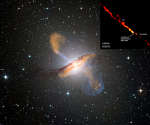 Jets from Unusual Galaxy Centaurus A
Jets from Unusual Galaxy Centaurus A
31.05.2011
Jets of streaming plasma expelled by the central black hole of a massive spiral galaxy light up this composite image of Centaurus A. The jets emanating from Cen A are over a million light years long. Exactly how the central black hole expels infalling matter is still unknown.
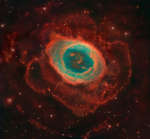 M57: The Ring Nebula
M57: The Ring Nebula
20.04.2012
Except for the rings of Saturn, the Ring Nebula (M57) is probably the most famous celestial band. Its classic appearance is understood to be due to perspective - our view from planet Earth looks down the center of a roughly barrel-shaped cloud of glowing gas.
 Planets Over Egyptian Pyramid
Planets Over Egyptian Pyramid
3.05.2022
The early morning planet parade continues. Visible the world over, the planets Jupiter, Venus, Mars and Saturn have been lining up in the pre-dawn sky since mid-April. In the featured image taken last month, these planets were captured over the Step Pyramid of Djoser, a UNESCO World Heritage Site.
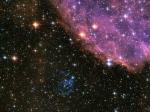 Supernova Remnant E0102 from Hubble
Supernova Remnant E0102 from Hubble
29.08.2006
It's the blue wisp near the bottom that's the remnant of a tremendous recent supernova explosion. The large pink structure looming to the upper right is part of N76, a large star forming region in our neighboring Small Magellanic Cloud (SMC) galaxy. The supernova remnant wisp, with full coordinate name 1E0102.
|
January February March |
||||||||||||||||||||||||||||||||||||||||||||||||||||||||